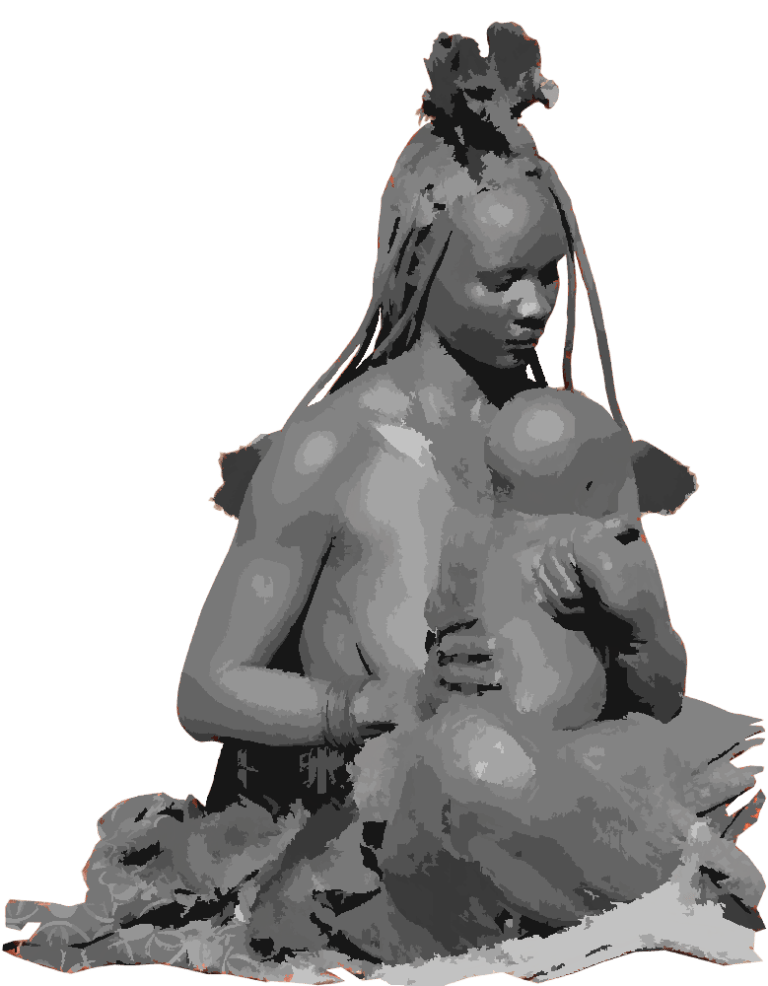What is Whuda Marble Art about? What were its beginnings and what is the origin and meaning of its logo? What comprises Whuda Marble Art and what is its purpose?
Our Story
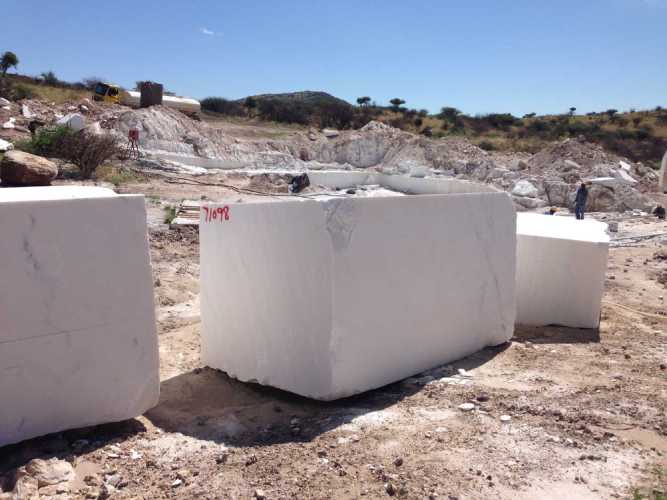
Beginnings
WHUDA MARBLE ART was initiated in 2018 when Namibia became griped in an economic recession. This encouraged the founder, Winfried Holze, to seek a new way forward. With an architectural, construction and art background, combined with the potential Namibia holds, Winfried realized that a new, internationally acclaimed and unique Namibian art and art identity through the medium of locally mined marble stone is needed. He subsequently embarked on establishing WHUDA MARBLE ART as a facility in which African marble art can be produced and skills transferred to budding young stone sculptors. The word WHUDA has its origins in the architectural practice of Winfried Holze Urban Design Architecture.
Our Team
Kambezunda Ngavee: Born August 1991 in Rietfontein, he attended Augustineum Secondary school, finishing grade 12, and subsequently proceeded to the College of the Art where he received his Diploma in Visual Art in 2017. He has participated in a number of workshops and exhibitions such as Tulipamwe International artist workshop, 2018, sculpture workshop at Dörte Berner on Farm Peperkorrel, 2017, and solo exhibition (set in stone) at the Franco Namibian Cultural Centre, 2018. Furthermore, he participated in the Gé Pellini Marble Sculpting Project for the Hunters United Against Poaching Trust in August 2017. Since March 2019 he is an active member of the WHUDA Marble Art team of marble sculptors.
Henry Coetzee: Born November 1984 in Oranjemund, he attended the South African College Schools, finishing grade 12. He subsequently visited Rhodes University (Grahamstown, SA)and UNISA where he received his B.A. (Culture and Arts) in 2015. Since then he has worked at a number of places amongst others at Namdeb, Oranjemund. Although he qualified in the visual IT arts and animations, his passion lies in the creation of real three-dimensional sculptural art, particularly stone art. Since March 2019 he is also an active member of the WHUDA Marble Art team of marble sculptors.
Winfried Holze: Born January 1963 in Windhoek, he attended St. Paul’s Collage, finishing his matric there. Thereafter he studied Architecture at the University of Port Elizabeth (now Nelson Mandela Bay University) with a B. Building Arts,1985, and B. Architecture, 1987. In 1991 he received his Master in Urban Design and City Planning at the University of Cape Town. After a short stay in Germany, Bamberg, he returned to Namibia to open his own architectural practice. During his stay in Germany he attended sculpture courses in stone to form an integral part of his architectural philosophy and practice. Later he was part of a private sculpture workshop community under the leadership of Franz Rosenklee from 1996 to 2002. What started off as a hobby, ended in the fully operational marble sculptors workshop- WHUDA MARBLE ART.
Sakkie Erasmus: Born March 1980 in Onamabili, he attended Oshilulu Combined School in Ondangwa, Owamboland. Thereafter he worked in Walfisbay on the fishingboates. He then moved to Windhoek where eventually he ended up at Whuda Marble Art, starting of as general handyman, to eventually moving up to forklift operator and even sculptor for small items. Apart from being a budding entrepreneur, i.e. converting his home (kambashu) into a small shop/ shebeen, he is also a solo vocalist by heart, having released one album already.
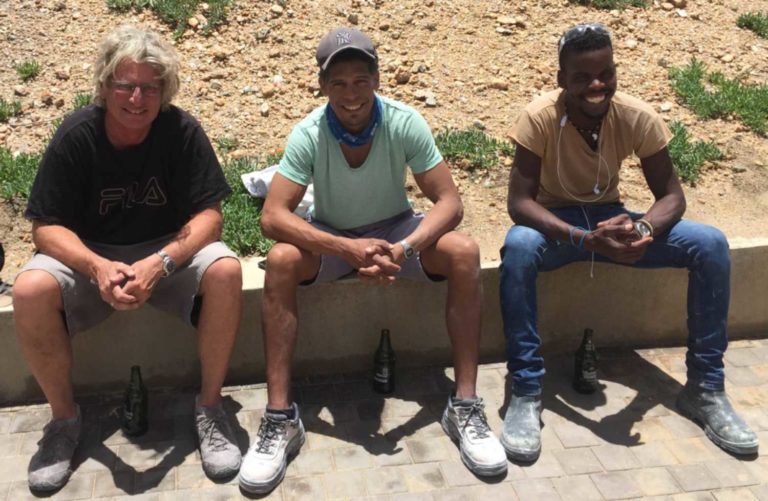

Our Workshop
We are situated in the northern industrial area of the capital city, Windhoek, surrounded by other manufacturing facilities in an industrial park. Our workshop consists of ±280m2 under roof work area, including offices, boardroom, ablutions and store rooms. We work primarily with Cuturi pneumatic power tools, hammers and chisels, electric grinders and polishers. There are various sizes of lifting equipment as well as a 5 ton forklift
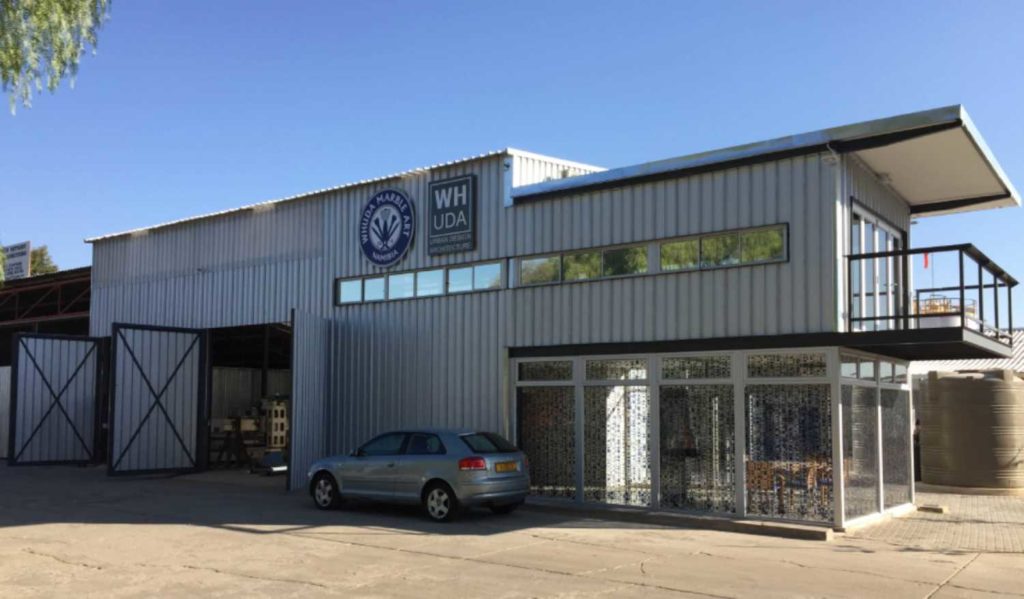
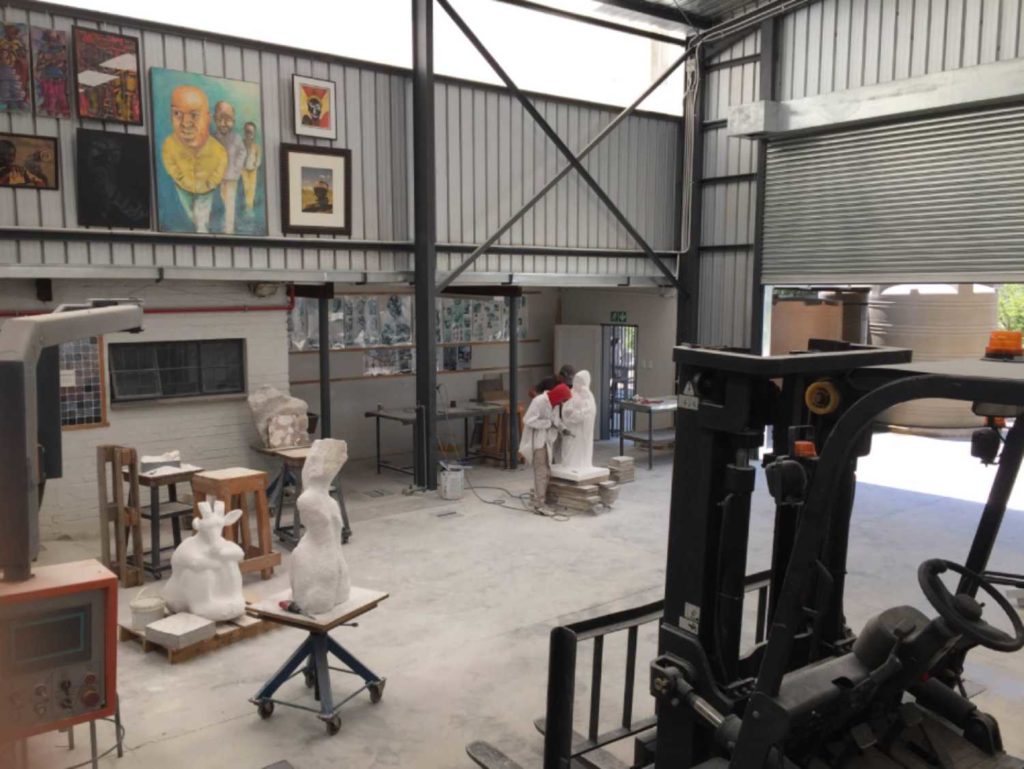
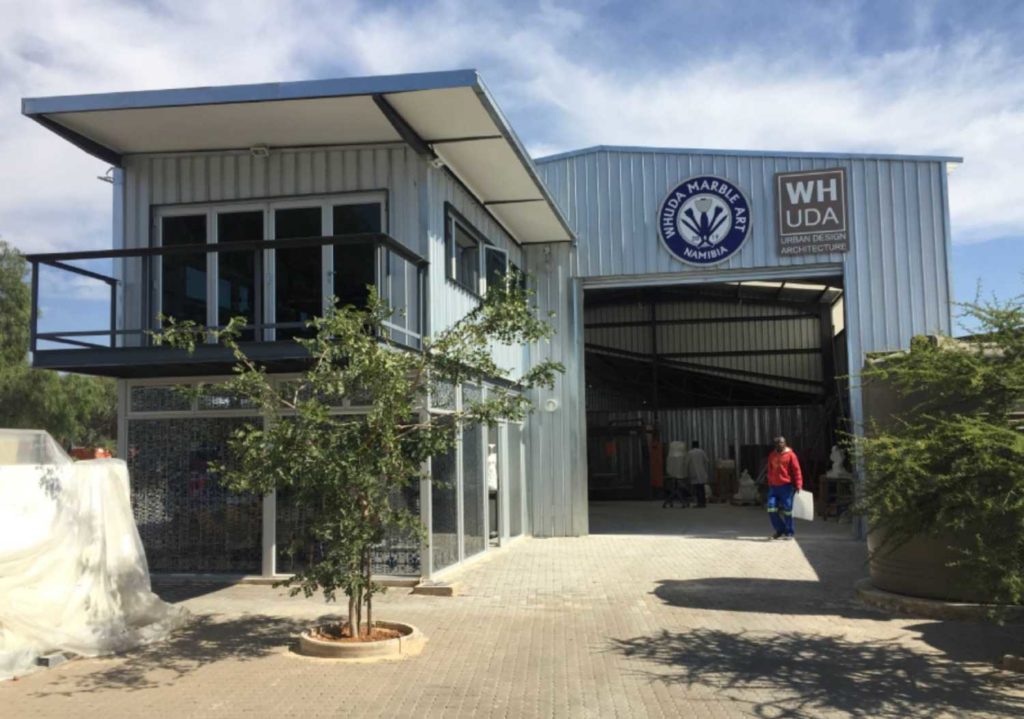
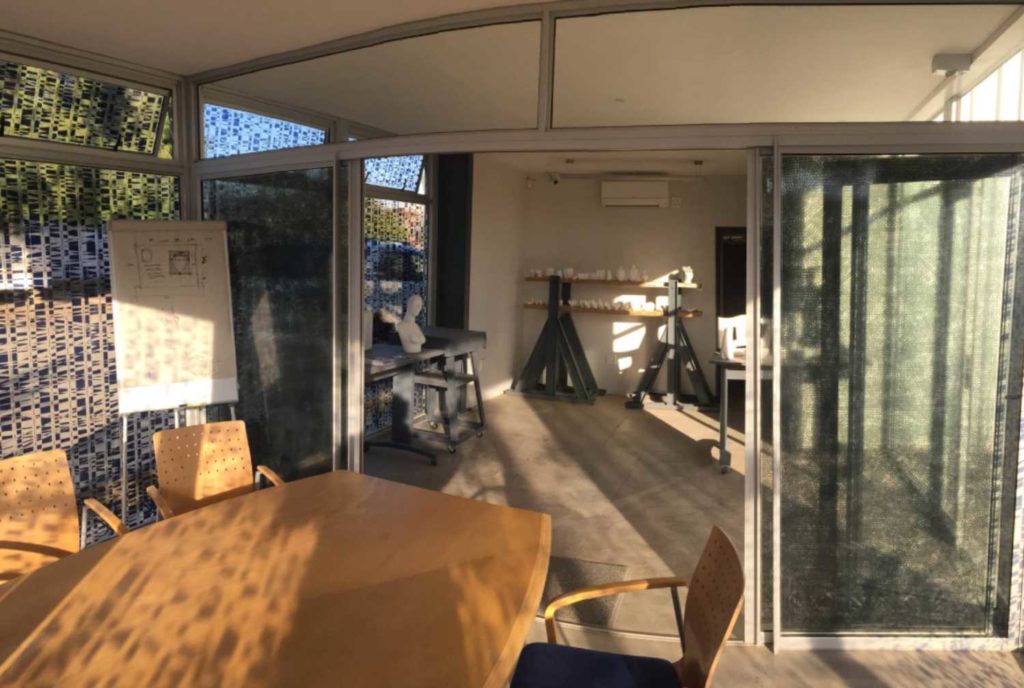
Our Purpose
- To produce small scale artworks for the tourist and interior decoration market in order to promote our art and the awareness of the availability of marble stone in Namibia.
- To produce art works on a commission basis, i.e. head stones, public art and artworks integrated into new or existing buildings.
- To produce self-expressions and/or theme-based art pieces, designed and motivated by the individual artists themselves, to be displayed in galleries and for sale to art collectors.
- To teach and transfer sculpture making skills and techniques in stone to young and old, who either just want to do it as a hobby or who wish to become qualified stone art sculptors.
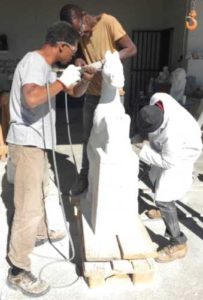
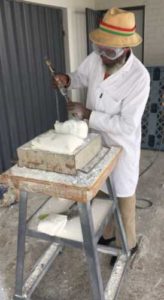
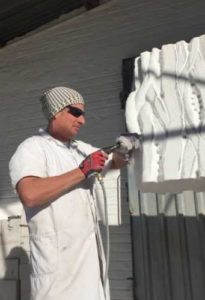
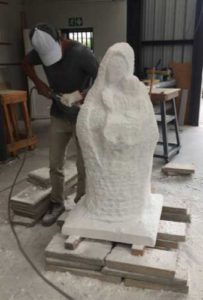
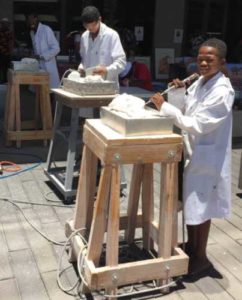
Our Logo Explained
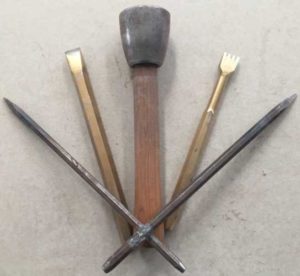



The logo was to be new, distinctive and meaningful, something with a historic reference and yet contemporary, even abstract, something recognizable, but distinctly African. To be avoided was something with a reference to Africa like a lion’s head or the Namibia map and flag. It needed to portray the action, purpose and work of a stone sculptor or the process of stone sculpting. Other criteria were that this emblem should stand the test of time, be recognisable. It should offer the ability to be incorporated into another coat of arms or logo of a person that has worked at WHUDA MARBLE ART but wishes to open his/her own workshop. In so doing, that person recognises and is being recognized of having passed through this workshop and thus the legacy lives on.
Guiding emblems were the European/German coal miners, i.e. two hammers crossing each other at 450, or the hammer and sickle in the Russian flag. Thus, a direct reference to work or maybe even more than that, like the compass and setsquare in the Freemasons’ logo – it needed to be just as powerful and identifiable in future. Those carrying this symbol will be identified as a special breed of people, belonging to a special group – the group of Namibian/African stone sculptors/artists.
The elements of the logo should not be grouped into a strict 450 inflexible, authoritarian, geometric shape but be free spirited, liberal, dynamic, and creative, yet formal enough to show honour and respect. A commitment and responsibility towards our past, our local and foreign ancestors and present peoples, our future generations, our heritage, our resources and environment and finally our country as a whole.
The traditional stone sculptor tools form the basis of the emblem, tools that are identifiable and specific to only this art and craft. In the middle is the hammer or mallet, an ancient tool. It probably was the very first tool that developed after the knife, and is now used in all arts, crafts and professions that require a unique hitting action. In our case, however, its head is smaller than the traditional wooden mallets, indicating that it is of metal, steel or iron, thus pointing towards adherence to an evolution of the same tool. It is round, has no edges or action heads like normal hammers, therefore distinctly not a normal hammer one gets at the hardware store. It is multidirectional and can be used at any angle, in any direction and with any force. It is shaped to give the artist greater freedom to focus on his art and not necessarily need to be conscious or careful as to where and how the hammer hits the chisel in order not to hurt himself.
To the left is the ‘flat iron’ used to flatten and even out irregularities in the sculpture. Its flat side points to the left, i.e. indicating a barrier to any negative or opposing energies coming from the back. To the right is the ‘toothed iron’ a chisel used to roughen up the stone in order to get to the final shape as quickly as possible. Its teeth are like a row of sharp chisels, each doing the same work of a single sharp chisel. It points up and to the right in the direction of a positive energy flow, indicating progress and aiming towards the future.
On either side of these chisels is a ‘pointed’ chisel. One of these could be interpreted as the ‘tracer’ chisel whilst the other is the ‘sharp’ chisel. This chisel is sometimes referred to as the ‘destroyer’ chisel, or first chisel, as it is used to bring the raw stone block to the approximate final shape of the sculpture. Thereafter the toothed or flat chisels are being applied. Both tools could also be seen as a kind of wreath enclosing or holding the other tools. The left chisel points to the left, to guard against evil from that side and the right one points up and right to indicate the way forward and upward.
Finally, the handle of the mallet is shaped ergonomically, meaning it fits correctly and snugly in a sculptor’s hand, thus implying human organic nature.
Where all the tools meet at the bottom, almost at the end, the crossing point is marked with a hole in the shape of a rhombus or diamond. This is a clear reference to the precious stones, found in Namibia, a reference to its wealth of natural resources, in particular its minerals like marble and granite. This shape is, however, also very common in the arts and crafts of the Owambo, Himba and Kavango, another reference to Namibia, but also to African art as a whole. Apart from this, the rhombus is a symbol of matter and spirit unification, which is exactly what a sculpture is all about.
When looking at the emblem overall at a glance, the following images may also come to mind:
That of a campfire or grass bundle in the Namibian Bush. A campfire is a place around which we Namibians like to sit and tell stories. Or that of a Cannabis leaf, a plant with endless uses and potential, spiritual and otherwise. Or images of African sculptures – a direct reference to its origin, i.e. Africa and Namibia: Crossed legs, short legs spread open in a rhombus shape or arms held up high, rhombus patterns, round-shaped heads like a mallet, Bushman engravings, carved Ostridge eggs and shells, etc.
